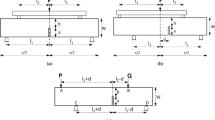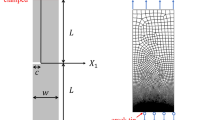Abstract
In this paper the applicability of the load normalization method to determine J-R curves of polypropylene copolymers (PP) is analyzed. This method allows the determination of resistance curves ideally from a single fracture test, and it is based on the load separation principle, which assumes that load can be separated in two multiplicative functions, the geometry function, G(a/W), and the deformation function, H(νpl/W), which depend of the crack depth and the plastic displacement, respectively. The load separation validity has been checked for two different PP copolymers (block and random copolymers) and the load normalization method has been applied in order to determine and analyze the resistance curves, which have been compared, as a reference, with those obtained by the multiple specimen method. The applicability of the load normalization method to PP copolymers is analyzed by introducing some variations in the general procedure: Firstly, the deformation function is determined using either a power law fit or the so-called LMN function. With the power law, two different fitting methods have been tested: the usual “6 + 1” method and a “6 + 6” method proposed here for giving more weight to the final point of the curve. Secondly, the influence of the material crack tip blunting has been analyzed quantifying it through different values of the constriction factor (m) in the general expression of the blunting line. Finally, the effect of the separable blunting region extension on the J-R curve has been also analyzed by establishing different separable blunting zones.
Similar content being viewed by others
References
J. R. Begley and J. D. Landes, in “Fracture Toughness,” STP 514 (ASTM, Philadelphia, 1972) p. 1.
ASTM E813–87 in “Annual Book of ASTM Standards,” Part 10 (ASTM, Philadelphia, 1987) p. 686.
ESIS Technical Committee 4 (European Structural Integrity Society, March 1991).
J. R. Landes and R. Herrera, Int. J. Fract. 36 (1988) R9.
H. A. Ernst, P. C. Paris, M. Rossow and J. W. Hutchinson, in “Fracture Mechanics,” STP 677 (ASTM, Philadelphia, 1979) p. 581.
H. A. Ernst, P. C. Paris and J. D. Landes, in Fracture Mechanics: Thirteenth Conference, STP 743 (ASTM, Philadelphia, 1981) p. 476.
M. H. Sharobeam and J. D. Landes, Int. J. Fract. 47 (1991) 81.
Idem., ibid. 59 (1993) 213.
Idem., ibid. 61 (1993) 379.
J. D. Landes, Z. Zhou, K. Lee and R. Herrera, J. Test. Eval. 19 (1991) 305.
C. R. Bernal, A. N. Cassanelli and P. M. Frontini, Polym. Test. 14 (1995) 85.
C. R. Bernal, P. E. Montemartini and P. M. Frontini, J. Polym. Sci., Part B: Polym. Phys. 34 (1996) 1869.
M. Che, W. Grellmann, S. Seidler and J. D. Landes, Fatigue Fract. Engng. Mater. Struct. 20 (1997) 119.
J. D. Landes and Z. Zhou, Int. J. Fract. 63 (1993) 383.
Z. Zhou, J. D. Landes and D. D. Huang, Polym. Engng. Sci. 34 (1994) 128.
V. Garcia-Brosa, C. Bernal and P. Frontini, Engng. Fract. Mech. 62 (1999) 231.
R. Herrera and J. D. Landes, in Fracture Mechanics: Twenty-First Symposium, STP 1074 (ASTM, Philadelphia, 1990) p. 24.
T. W. Orange, in Fracture Mechanics: Twenty-First Symposium, STP 1074 (ASTM, Philadelphia, 1990) p. 545.
V. Kumar, M. D. German and C. F. Shih, An engineering approach for elastic-plastic fracture analysis, EPRI Report NP1931, 1981.
C. Bernal, A. Cassanelli and P. Frontini, Polymer 37 (1996) 4033.
J. R. Rice, J. Appl. Mech. 35 (1968) 379.
R. Herrera and J. D. Landes, Int. J. Fract. 16 (1988) 427.
C. Bernal, M. Rink and P. Frontini, Macromol. Symp. 147 (1999) 235.
J. R. Rice, P. C. Paris and J. G. Merkle, in “Progress in Flaw Growth and Fracture Toughness Testing,” STP 536 (ASTM, Philadelphia, 1973) p. 231.
J. Chakrabarty, “Theory of Plasticity” (McGraw-Hill, Singapore, 1987) p. 11.
A. N. C Assanelli and L. A. deVedia, Int. J. Fract. 83 (1997) 167.
J. I. Velasco, C. Morhain, D. ArencÓn, O. O. Santana and M. L. Maspoch, Polymer Bulletin 41 (1998) 615.
W. Grellmann and M. Che, J. Appl. Polym. Sci., 66 (1997) 1237.
Y. Han, R. Lach and W. Grellmann, Angew. Makromol. Chemie 270 (1999) 13.
I. Narisawa, Polym. Engng. Sci. 271(1) (1987) 41.
Author information
Authors and Affiliations
Rights and permissions
About this article
Cite this article
Morhain, C., Velasco, J.I. Determination of J-R curve of polypropylene copolymers using the normalization method. Journal of Materials Science 36, 1487–1499 (2001). https://doi.org/10.1023/A:1017500930544
Issue Date:
DOI: https://doi.org/10.1023/A:1017500930544




